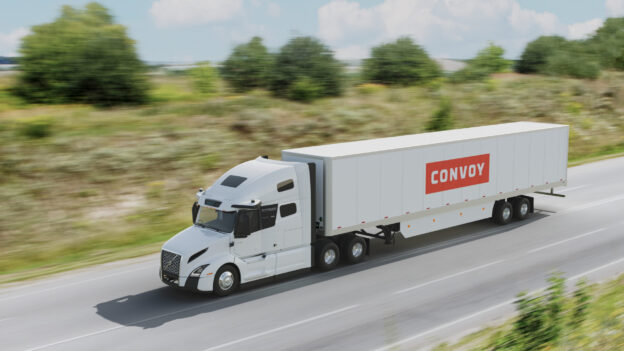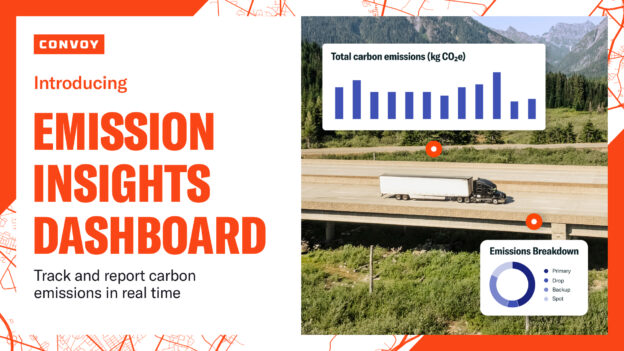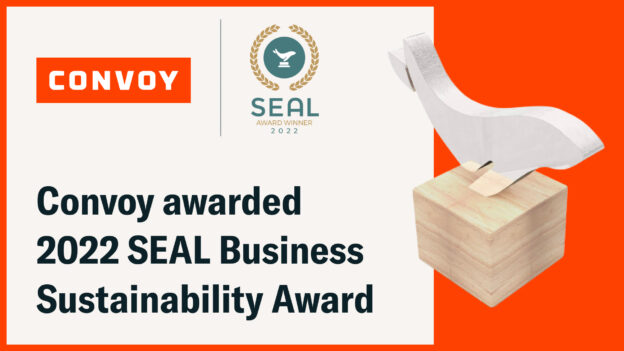What on earth are carbon offsets?
Sustainability • Published on June 4, 2020

Aggressive mitigation and adaptation policies to reduce carbon emissions have become a top priority for many companies, celebrities, cities, countries, and organizations as they work to reduce their contributions to climate change — if not eliminate them entirely. The shared solution: buying carbon offsets. Companies aiming to be carbon-neutral believe offsets help provide the “net” in their “net-zero emissions” goals. If you are relatively new to the sustainability conversation, you might be thinking, “WTF are carbon offsets?”
Aaron Grunfeld, founder at Patch, is here to help us better understand the concept as part of Convoy’s The Business of Carbon Emissions video series. Patch is a carbon offsetting platform which helps businesses purchase carbon offsets to make any transaction or emissions events carbon neutral. Using Patch, businesses can either pay for the offsets themselves or pass the choice on to their consumers to help them participate in the carbon offset marketplace.
Aaron explains the answers to our most burning carbon offset questions:
- What is a carbon offset?
- What makes for a good carbon offset vs. a bad carbon offset?
- What is the best way to research whether an offset is legitimate?
- How are carbon offsets priced?
- What are some of the bigger challenges involved with carbon offsetting?
- How has carbon offsetting changed in the last decade?
- What’s the most important thing people should know about carbon offsets?
By providing examples of carbon offset projects — like a forestry implementation where the growth of trees absorbing CO2 from the atmosphere works to reduce future emissions into the atmosphere — Aaron helps us to better understand how to mitigate our environmental footprint and more easily evaluate whether specific carbon offset projects have verifiable long-term value.
Watch the video here or read the transcription below.
You can learn more about The Business of Carbon Emissions and view our other videos on carbon emissions business.
Convoy provides shippers reliable, flexible, and instant capacity when they need it most. Learn more about shipping with Convoy today.
TRANSCRIPTION
Jennifer Wong: Hi everyone, my name is Jennifer. I lead sustainability here at Convoy and today we’ll be learning about carbon offsets. Companies, celebrities, cities, countries and organizations all have made commitments to reduce their carbon emissions to climate change, if not eliminate them entirely and they all have one tactic in common, buying carbon offsets. For companies aiming to be carbon neutral, offsets help provide the “nets” in their “net zero” emissions goals. So, these businesses are fueling a multi-billion-dollar market for one of the more popular, and sometimes more controversial tactics to eliminate greenhouse gases. Carbon offset projects have a long history of overpromising and under delivering, but advocates do say that there’s enormous potential for offsets to combat climate change, protect nature, and route money to the parts of the planet that need it the most. So today, we have Aaron Grunfeld, founder of Patch, to answer all of our questions and demystify carbon offsets. So, welcome Aaron.
Aaron Grunfeld: Thank you. Thank you for having me.
Jennifer: So, before we kick things off, I want to share a little bit about you. You are a startup vet who launched Saunder and really helped build it into a billion dollar hospitality company but you’re recently shifted your focus towards fighting climate change by starting this company called Patch, could you tell us a little bit more about what Patch is?
Aaron: Yeah, absolutely. We’re joining a handful of San Francisco startups who are dedicated to innovating in the climate tech space. So, Patch is a carbon offsetting platform and how it works is businesses can actually purchase carbon offsets through our API to make any transaction or emission events carbon neutral. Businesses have the choice to actually pay for the offsets themselves [2:00] or pass the choice onto their consumers so that customers can actually participate in the carbon offset marketplace and our goal is to build the underlying infrastructure to power a carbon neutral economy.
Jennifer: And so, we’ve already both said “carbon offsets” five or six times. Could you explain what a carbon offset actually is?
Aaron: Yeah. So, the complicated answer, or the specific answer is the offset is a certification that represents one metric ton of sequestered or reduced CO2 equivalence and this sequestering or reduction process is happening through a carbon offset project. So, projects can range anywhere from a forestry project where, you know, through the growth of trees they’re absorbing CO2 from the atmosphere to electricity efficiency or renewable energy projects that are actually working on reducing future emissions into the atmosphere. There’s a price associated with an offset and the reason why that is and the reason why they exist is, well for individuals and businesses, they’re a mechanism to essentially offset your emissions for a specific event. For example, you’re taking a flight or you’re shipping a container across North America, there’s going to be emissions in the atmosphere there and so you can purchase offsets and essentially mitigate your environmental footprint. And then the other side, or the other reason is these projects, they’re expensive to run and there’s a lot of capital involved in getting them off the ground and if we want to make a positive impact towards, you know, slowing down climate change we need more and more of these projects to exist. We need them to continue operating [4:00] and so, they’re essentially a way to fund these projects.
Jennifer: And as you talk about all of the different type of projects that these offsets can be going towards, or contributing to, could you explain what a good carbon offset is versus a bad offset, if that even exists itself?
Aaron: Yeah, so when you’re looking for an offset, we’ll focus on the good, you want to make sure that it’s primarily been verified, and what that means is when a project wants to, or when a project developer has decided that they want to do a project, they put out a methodology on how they’re going to reduce or sequester CO2 and that methodology is then peer reviewed by other scientists but furthermore, third party organizations will actually come in and audit the whole process. They’re going to put it through kind of like a rigorous evaluation step and so, you know, through that you can ensure that if a project has been verified by a standard, some main ones are Climate Action Reserve, Verified Carbon Standard, that’s VCS, and the American Carbon Registry, those are some of the top tier verification standards. If you’re purchasing an offset that has one of those standards, that’s audited the process and you know that it’s been validated and that’s legitimate. Other things to look out for are whether or not the project was created on the basis of additionality. So, additionality is a term in the carbon offset world that basically describes a project that was produced for the sole purpose of reducing or sequestering CO2. So an example of a non-additional project that, you know, still through the market can obtain funding would be a land owner that has [6:00] already a forest pre-existing and has decided as opposed to building on that land they’re going to generate revenue through offsets. So, that’s a non-additional project. And then another thing to look out for is this concept of leakage. This typically happens in greenhouse reduction projects where they’re actually focused on protecting forestry for example. So, what happens is they may be protecting it in one, you know, part of the land, however, loggers are going to come in and tear it down might actually just go elsewhere. And so, you’re actually just kind of shifting the risk across to another part, right, that’s very close by. So, verification, additionality, and leakage are the three things you want to look for in a really good offset.
Jennifer: And as someone is looking for those three different items for their checklist, how do they go about and do that research? Is that pretty readily available?
Aaron: Sometimes it is, sometimes it isn’t. If it is a good offset, they’re going to definitely highlight those factors. They’re also going to highlight another criterion which is permanence. And so, if you’re buying an offset that’s been verified by one of those standards, you know that it’s legitimate and that it’ll meet those requirements. However, there are other projects that exist that are, they’re doing good things for the community, they’re creating jobs but they’ve decided not to go through the verification process and so you simply just cannot confirm that the kind of emissions that you’re trying to offset are going to be accurate or in fact, they were produced.
Jennifer: And then you mentioned the buying offsets side, could you explain a little bit more around how offsets are priced? When I [8:00] have just done simple research looking for carbon offsets, I’ll see different projects or collaborations that have widely different prices. How is that determined today?
Aaron: Yeah, so there’s a lot of factors that go into pricing but primarily its based off of the initial debt and investment that have to go into the projects and the op x that’s required to operate it and these projects need to pay that back so they continue to operate and so that they can open new projects up. And then, you know, as I mentioned there’s a wide variance of different projects so that leads to different costs. A forestry project will definitely cost different than a renewable energy project and then of course, the location of which they’re happening, the materials, the labor, all that stuff, it’s going to be priced differently. So, bundle that all together to produce an offset price. They’re other factors as well like whether or not the offsets have co-benefits and what those co-benefits are, as well as the year those offsets were produced. And then another thing to keep in mind, the source in which you’re buying them from. So if you’re buying from a retailer or a broker, or maybe a sustainability consultant, you should expect there to be a few layers of commission added on to the actual price of the offset but if you’re an organization that’s able to work directly with a project development and partner with them, although they might have some high minimum purchase requirements, you know that you’re as close to the source as possible.
Jennifer: Great. So, buy as close to the source as possible. That’s going to be your biggest bang for carbon offsets.
Aaron: Absolutely, but at the same time, you know, some organizations feel really aligned with the values of one project, and although it might cost more for certain offsets, they’re going to say “Hey…”
Jennifer: We want to make it happen.
Aaron: Exactly. So, it’s really the profits [10:00] with the organization.
Jennifer: I would say so far offsets sound great. Could you maybe describe a little more around the problem of carbon offsetting? What are some of the problems with the whole carbon offsetting process?
Aaron: Well so there were a lot of problems, more problems then there are today back in 2007, 2008 on the supply side when projects were kind of claiming that they were reducing CO2 and they weren’t, or they weren’t as well verified as they are today and that’s why the auditing process has become very rigorous. However, there’s still a problem on the purchasing side, where for example, a business is claiming to be operating carbon neutrally and offsetting all their emissions when, you know, they’re really doing a retroactive ballpark on what those emissions were and just kind of purchasing a bunch of offsets in bulk. We can hold projects more accountable today through third party verification standards but businesses and individuals that were purchasing and making claims need to be held accountable as well. That comes down to something we’re passionate about at Patch which is being able to actually calculate emissions as they’re happening and tying specific offset certifications to those specific transactions or events that actually produced the emissions. That way you’re not doing it retroactively, it’s happening upfront, and you know that you’re actually netting out the impact that’s happening as your business operates.
Jennifer: And can we talk a little bit around the innovation that’s happening in carbon offsets today? It sounds like it’s a category that’s [12:00] evolved over time, especially when you mention in 2007, that the world of carbon offsets is very different from today’s world of carbon offsets.
Aaron: Yeah. So, there’s a lot of innovation, or there’s been a lot of innovation on the supply side mostly over the past few years. There are startups that are working on improving the verification process for forestry projects. So they’re using drones that can scan forests and calculate what the density of the forests are and making it more accurate to claim, you know, how many offsets are being produced as opposed to having to go manually and measure trees. There’s also a very cool company called Carbon Engineering that’s been working on actually a new, or a newer approach to carbon sequestration, which is direct air carbon capture. And what they’re doing is they’re actually sucking carbon out of the air and either producing or recycling it into low emission fuel or actually turning that CO2 into rocks and burying it underground permanently. Which is a form for geo sequestration. Which I think is awesome. So, a lot of innovation on the supply side but, you know, there hasn’t been enough on the demand side and that’s part of the reason why we want to start Patch. Again, you know, the market is still very opaque, it’s still very complicated, and you want to ensure that you’re buying things from verified standards and you’re working with legitimate projects and you also want to make sure that you’re offsetting in a responsible way. And that’s actually what we’re trying to facilitate at Patch.
Jennifer: And just to close up, could you share the most important thing that people should know about carbon offsets?
Aaron: Yeah. Well so we’ve built like 200 years worth of infrastructure that relied on the assumption that we could just [14:00] burn fossil fuels forever and we now know that that’s not true and so, although it would be great, we’re still far from electric planes and they’re still going to be emissions that we’re not able to reduce and that are unavoidable. And so, I’d say main takeaways are carbon offsets should be used as a complementary approach to taking responsibility on your environmental impact and if you are going to offset, do so responsibly by working with verified projects and also actually just calculating your emissions as they’re happening and ensuring that you’re doing so in a programmatic way. If you do those things, you can feel good about carbon offsetting.
Jennifer: Awesome. Well, thank you Aaron so much for joining us for our series today. I personally learned so much about carbon offsets. I’m excited to dig in even further. Again, thank you for joining us.
Aaron: Absolutely. Thank you for having me.



